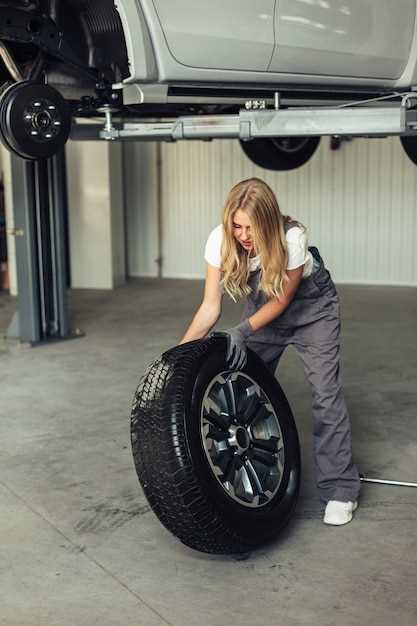
In the world of supercars, performance is paramount, and every detail counts towards achieving the ultimate driving experience. One crucial aspect that often goes overlooked is the balancing of wheels. Proper wheel balancing plays a significant role in enhancing vehicle dynamics, providing optimal grip, and ensuring stability during high-speed maneuvers. When wheels are not balanced correctly, the car can experience undesirable vibration, affecting both performance and driver comfort.
For supercars, where precision engineering is a hallmark, the consequences of poorly balanced wheels can be profound. Vibrations can lead to premature tire wear, compromised handling, and even impact the effectiveness of advanced suspension systems. Hence, understanding the importance of wheel balancing becomes essential for any enthusiast seeking to maximize their vehicle’s potential on the road or track.
Balancing wheels is not merely a routine maintenance task; it is a fundamental practice that underpins the performance capabilities of supercars. This article delves into the methodologies and technologies employed in properly balancing wheels, illustrating how a fine-tuned setup contributes to an unparalleled driving experience. Let’s explore the intricate relationship between wheel balancing, vehicle performance, and the exhilarating world of supercars.
Understanding the Importance of Wheel Balancing for Supercars
Wheel balancing is a fundamental aspect of maintaining supercar performance and safety. Properly balanced wheels not only enhance driving experience but also prolong the life of the vehicle’s components.
When wheels are unbalanced, they can generate excessive vibration, which leads to various issues:
- Tire Wear: Unbalanced wheels can cause uneven tire wear, leading to premature tire replacement.
- Suspension Damage: Continuous vibrations can stress the suspension system, resulting in costly repairs.
- Handling Issues: A lack of balance can impair the vehicle’s handling characteristics, causing inconsistency in steering response.
- Driver Comfort: Vibrations can make driving unpleasant, affecting both comfort and focus.
For supercars, where speed and precision are critical, the importance of wheel balancing is magnified. High-performance vehicles utilize advanced technology and design to achieve optimal performance; thus, maintaining balance is essential.
Moreover, balancing must be regularly checked, especially after tire installation or rotation. Here are key benefits of proper wheel balancing:
- Enhanced Stability: Balanced wheels provide stability at high speeds, decreasing the likelihood of loss of control.
- Smoother Ride: Wheel balancing eliminates vibrations, resulting in a smoother and more enjoyable ride.
- Prolonged Lifespan: Correctly balanced wheels help extend the lifespan of tires and vehicle components.
In conclusion, ensuring wheels are properly balanced is vital for supercars. It maximizes performance, enhances safety, and contributes to a superior driving experience.
Common Causes of Wheel Imbalance in High-Performance Vehicles
Wheel imbalance in high-performance vehicles can significantly affect handling, safety, and overall driving experience. One of the primary causes of this imbalance is the uneven distribution of weight across the wheel assembly. This can result from manufacturing discrepancies or wear and tear over time, leading to vibration during operation.
Another common factor is the accumulation of debris, such as dirt, dust, or build-up of materials in the rim area. This accumulation can alter the weight distribution, thereby contributing to wheel imbalance and the unwanted vibrations that accompany it.
Tire wear also plays a crucial role in wheel balance. Uneven tire wear can create differences in weight and profile, resulting in instability at high speeds. Furthermore, improper mounting of tires can lead to misalignment, further exacerbating the imbalance and causing a decrease in handling performance.
Using incorrect or damaged wheel weights can also lead to imbalance. If balancing weights are lost or improperly placed, the wheel may not achieve a uniform distribution of mass, resulting in vibration that can compromise vehicle stability.
Lastly, physical damage to the wheel, such as bent rims from potholes or curb impacts, can disrupt balance. A damaged wheel alters the geometry and weight distribution, leading to vibrations that affect the driving experience and overall performance of high-performance vehicles.
Tools and Techniques for Accurate Wheel Balancing

Achieving precise wheel balancing is crucial for optimizing the performance of supercars. Several essential tools and techniques are utilized to ensure that wheels are balanced correctly, enhancing handling and stability during high-speed operation.
One of the most common tools used for wheel balancing is the dynamic wheel balancer. This machine spins the wheel at various speeds to determine any imbalance. The machine provides readings that indicate where weight needs to be added or removed, allowing for accurate adjustments. Dynamic balancing is particularly important for supercars, as it considers both static and dynamic weights, ensuring a smoother ride.
Another valuable tool is the bubble balancer. While less sophisticated than its dynamic counterpart, it serves well for smaller tasks or when a quick check is required. The wheel is mounted on a spindle, and the bubble level indicates any imbalance. Although it’s less precise for high-performance vehicles, it can be a practical option for basic maintenance.
Weight strips are critical components in the balancing process. These adhesive or clip-on weights are used to correct imbalances identified by the balancer. Selecting the appropriate type and placement of these weights is vital; improper use can lead to further imbalance and adversely affect vehicle performance.
Techniques for accurate balancing also include ensuring wheels are properly cleaned and inspecting tires for any damage. Dirt or debris can cause misleading readings, while worn tires can contribute to uneven weight distribution. Also, high-quality tires designed for supercar applications often have specific guidelines for mounting and balancing, which must be followed meticulously.
Lastly, performing regular checks and adjustments is essential for maintaining optimal wheel balance. Seasonal changes and wear over time can shift weights, making periodic balancing necessary. Being proactive with wheel maintenance ensures that supercars perform at their peak, providing safety and a superior driving experience.
Identifying Signs of Vibration When Driving Supercars
When experiencing vibrations in a supercar, it’s crucial to identify their source promptly. Vibrations can significantly affect handling, stability, and overall performance. Here are some common signs that may indicate issues with your supercar’s wheels or other components.
| Sign of Vibration | Possible Cause |
|---|---|
| Steering Wheel Vibrates | Misalignment or unbalanced wheels |
| Seat Vibration | Engine or drivetrain issues, or poorly balanced tires |
| Vibration at High Speeds | Wheel imbalance, bent rims, or worn suspension components |
| Noise Accompanying Vibration | Potentially loose wheel bolts, damaged bearings, or tire issues |
| Uneven Tire Wear | Improper wheel alignment or balancing problems |
Regular maintenance and prompt inspections are essential to mitigate any vibrations. If these signs are observed, it’s advisable to consult a professional service to diagnose and resolve any underlying issues to maintain peak performance.
Steps to Achieve Optimal Wheel Balancing Results
Achieving optimal wheel balancing is crucial for maximizing the performance of supercars. Properly balanced wheels enhance handling, prolong tire life, and improve overall driving experience. Here are the essential steps to ensure effective wheel balancing:
1. Inspect the Wheels and Tires
Before beginning the balancing process, thoroughly inspect the wheels and tires for any signs of damage, uneven wear, or foreign objects. This initial assessment ensures that the components are in good condition, which is vital for precise balancing.
2. Clean the Wheel Assembly
Remove any dirt, brake dust, or debris from the wheel and tire surfaces. A clean wheel assembly enables accurate measurements during the balancing process, as contaminants can lead to false readings.
3. Mount the Tire on the Balancer
Carefully mount the tire and wheel assembly onto a wheel balancer. Make sure that the setup is securely positioned and that the balancer is calibrated for the specific wheel size and type. This ensures that the balance measurements are precise.
4. Conduct a Static and Dynamic Balance Check
Perform both static and dynamic balance checks. Static balancing identifies weight distribution when the wheel is stationary, while dynamic balancing evaluates weight distribution during movement. Both checks are essential for identifying any imbalance.
5. Add Weights as Necessary
Based on the results of the balance checks, add appropriate weights to the wheel. Weights can be placed either on the inside or outside of the wheel rim, depending on where the imbalance is located. Ensure that the weights are securely attached for optimal performance.
6. Re-check the Balance
After adding the weights, re-check the balance to confirm that the adjustments have corrected the previous imbalances. This step is crucial to verify that the wheel is now perfectly balanced before reinstalling.
7. Test Drive the Vehicle
Finally, conduct a test drive to assess the performance of the balanced wheels. Pay attention to vibrations, handling, and overall ride comfort. If any issues persist, revisit the balancing process to make further adjustments as needed.
By diligently following these steps, you can achieve optimal wheel balancing results, enhancing the performance and stability of your supercar.
Maintaining Wheel Balance for Long-Term Supercar Performance

Proper wheel balance is crucial for maximizing the performance and longevity of supercars. It refers to distributing the weight of the wheel and tire evenly around the axle, which prevents unwanted vibration during operation. An unbalanced wheel can lead to a myriad of issues, from decreased handling responsiveness to increased tire wear.
Regularly scheduled maintenance is essential to ensure that wheel balance is maintained over time. As tires wear, they can lose their symmetrical shape, leading to imbalances. Additionally, external factors such as road conditions and driving habits can also contribute to wheel distortion. Therefore, periodic inspections should include checks for any signs of uneven wear or damage to the wheels and tires.
If vibration is detected while driving, immediate attention is required. This can indicate an imbalance that may affect not just the driving experience but also the vehicle’s performance. Addressing such issues early can prevent further damage to other components, such as the suspension and steering systems.
Utilizing advanced balancing techniques and equipment can enhance the precision of the balancing process. Electronic wheel balancers are particularly effective, providing detailed readouts that help technicians achieve optimal weight distribution. In addition, using quality weights and ensuring they are affixed securely can contribute significantly to maintaining balance over time.
In conclusion, maintaining wheel balance is a fundamental aspect of preserving supercar performance. Consistent monitoring, timely interventions for vibration issues, and utilizing cutting-edge technology will ensure that the wheels operate efficiently, providing the ultimate driving experience and enhancing the vehicle’s overall lifespan.
